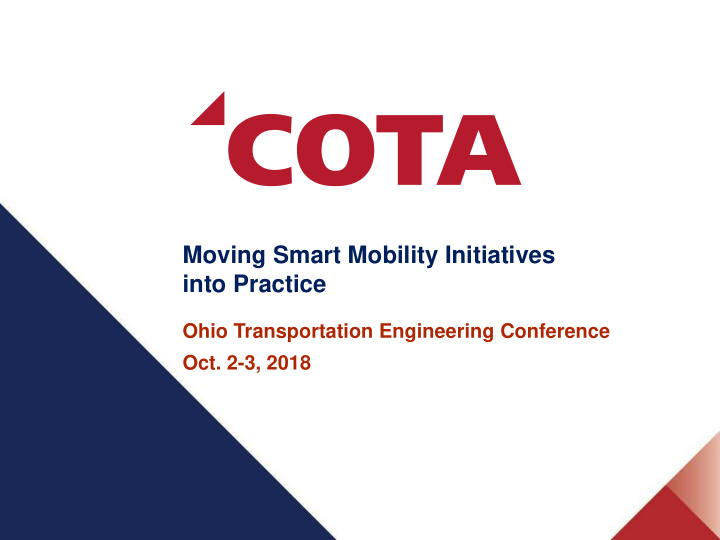



Moving Smart Mobility Initiatives into Practice Ohio Transportation Engineering Conference Oct. 2-3, 2018
ABOUT THE CENTRAL OHIO TRANSIT AUTHORITY • Nearly 19 million trips annually (60,000 daily trips) • 562 square-mile service area with 1.2 million residents • 2017 operating budget - $134 million • Total of 0.5% sales tax • 1,100+ employees, more than 700 coach operators • 327 buses, among the youngest in the industry • Named Outstanding Public Transportation System in North America for 2018 by the American Public Transportation Association 2
MOBILITY MATTERS
MOBILITY MATTERS • Reliable transportation is crucial to employers and the economy • By 2050… • 1 million new residents • 600,000 new jobs • COTA will be the region’s mobility leader. 4
COTA’S EVOLVING ROLE • To be the region’s Mobility Services Integrator • Economic development partner, Example of the advisor, solutions provider integration that’s coming: Uber is creating a transit • Using data, technology and division collaboration o Able to be nimble, making decisions and predicting outcomes using real-time data o Technology revolutionizing transportation o Collaborations with public and private organizations 5
TRANSIT INITIATIVES
TRANSIT SYSTEM REDESIGN – MORE & BETTER WITH THE SAME BUDGET • Launched May 2017 • Simplified bus routes • More direct service • More frequent service • New & improved connections to destinations High-frequency routes 89% accessible to 103,000 more residents High-frequency routes 71% within walking distance of 100,000 more jobs 7
NEW SERVICE – CMAX BUS RAPID TRANSIT • Corridor ridership up 16% since Jan. 1, 2018 • Service is 20% faster • $48.6M investment, $37.45M in federal funds • Real-time displays at BRT stops • Wi-Fi every bus and transit centers • Traffic signal priority at intersections • USB ports on every bus 8
SERVICE DEMAND 9
REGIONAL CORRIDOR ANALYSIS 10
FIRST MILE/LAST MILE STUDY Goal: Expand mobility options where gaps exist in the current transportation network and to locations not easily served by fixed-route transit. Equitable Access FLM services reduce barriers to access through taking a customer- first approach, providing multiple ways to access service using mobile apps, call centers and affordable fares. Real-time, point-to-point, on-demand service at the touch of a button. 11
SERVICE OPTIONS Personal Mobility on Demand – on-demand, individuals or small groups Flexible Microtransit – on-demand service, many riders Scheduled Microtransit – fixed-schedule service, many riders Vehicle Sharing – Bicycles, electric scooters, automobiles Supplemental Mainstream – Individuals or small groups 12
MOBILITY AS A SERVICE (MAAS) Shifting away from personally owned modes of transportation and toward mobility solutions that are consumed as a service. 13
FIRST MILE/LAST MILE AND MAAS Technology is an essential component • Mobile apps to request and pay for service • Trip planners to show time, mode and cost options • Inclusion of highly automated features in new models for future operators 14
TECHNOLOGICAL INNOVATION
NEW TECHNOLOGY – FREE WI-FI 16
NEW TECHNOLOGY – UPGRADED FAREBOXES 17
NEW TECHNOLOGY – REAL-TIME BUS INFORMATION 18
NEW WEBSITE – COTA.COM • All-new redesign with a • Mobile-responsive visual, customer-centric • ADA compliant approach • Real-time bus tracking and • Intuitive site mapping route updates every 15 seconds 19
SMART COLUMBUS 20
COTA-SMART COLUMBUS PROJECTS • Smart Columbus Operating System: COTA sharing data • Common payment system: COTA, city, Smart Columbus coordinating • Multi-modal trip planning: Plan and pay for trips all in one app • Smart Mobility Hubs: COTA facilities will host deployment • Mobility assistance for travelers with cognitive disabilities: COTA pilot • Connected electric automated vehicles: COTA implementing TSP, pedestrian warning systems • Non-emergency medical trips: COTA-supported • Connected vehicle environment: COTA-supported 21
QUESTIONS?
Recommend
More recommend